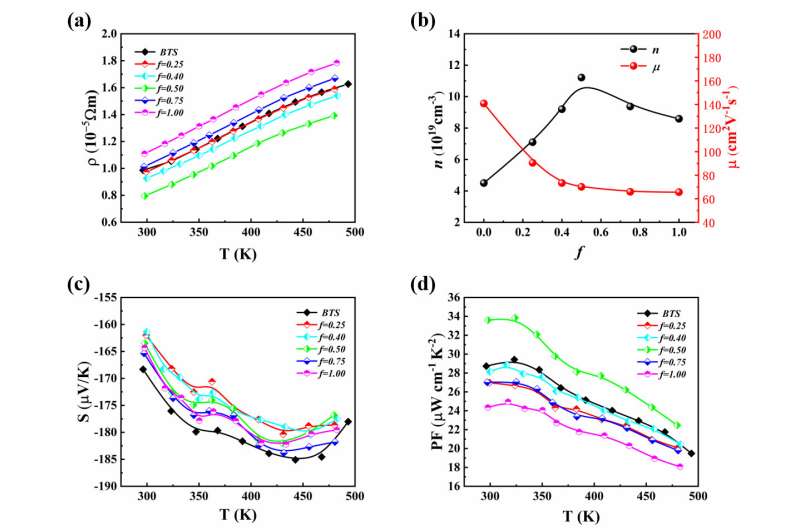This article has been reviewed according to Science X's editorial process and policies. Editors have highlighted the following attributes while ensuring the content's credibility:
fact-checked
trusted source
proofread
Scientists improve thermoelectric performance of n-type transition metal selenide through nanoinclusions

A research team led by Prof. Qin Xiaoying from the Hefei Institutes of Physical Science of the Chinese Academy of Sciences has improved the thermoelectric performance of an n-type transition metal selenide, Bi2Te2.7Se0.3 (BTS), by incorporating MnSb2Se4 (MSS) nanoinclusions. Results were published in two articles in the Chemical Engineering Journal.
Thermoelectric technology has received considerable attention as a potential solution to energy problems. However, the low thermoelectric value ZT (figure of merit) and energy conversion efficiency of N-type bismuth telluride currently limit its widespread commercial application. Nanoengineering is an effective way to improve the thermoelectric properties of materials, but selecting a suitable second phase can be challenging.
In this study, the researchers found that incorporating MnSb2Se4 into BTS can yield remarkable results.
Incorporated MSS nanoinclusions have been shown to have multiple benefits. It could simultaneously increase the power factor, resulting from the improved thermal performance due to the energy filtering effect and reduce lattice thermal conductivity originating from intensified phonon scattering by the dislocations.
The BTS/0.50wt%MSS composite sample demonstrated a maximum thermoelectric ZT of 1.23 at 345K, and an average ZT of 1.15 in the temperature range of 300–473K.
Notably, these values represented an approximate increase of 48% and 42%, respectively, over the matrix BTS. In addition, the composite sample exhibited improved mechanical properties, as evidenced by a 17% increase in its Vickers hardness.
The results indicate that the incorporation of the MnSb2Se4 secondary phase is an effective way to improve thermoelectric performance and mechanical properties of BTS.
The researchers have made significant progress in optimizing the thermoelectric properties of thermoelectric materials at room temperature. In 2022, they found that incorporating polyaniline nanoparticles into the BTS matrix could enhance phonon scattering and reduce the lattice thermal conductivity by 49% at 300K.
"It results in an 8% increase in power factor and a maximum ZTmax of 1.22 at 345K for the 1.5 wt% composite sample," said Chen Tao, a member of the team, "which is an attempt of organic compound, and also for the later inorganic-organic compound system research to lay a certain foundation."
More information: Shuhuan Yang et al, Enhanced phonon scattering and thermoelectric performance for N-type Bi2Te2.7Se0.3 through incorporation of conductive polyaniline particles, Chemical Engineering Journal (2022). DOI: 10.1016/j.cej.2022.140923
Tao Chen et al, Enhancing thermoelectric performance of n-type Bi2Te2.7Se0.3 through the incorporation of MnSb2Se4 nanoinclusions, Chemical Engineering Journal (2023). DOI: 10.1016/j.cej.2023.143397
Provided by Chinese Academy of Sciences


















